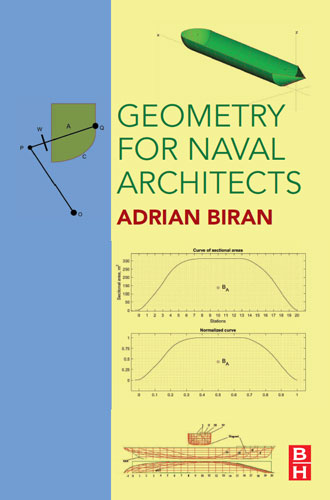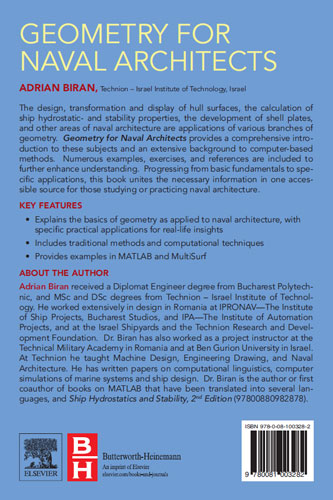Сб с 10 до 16
Geometry for Naval Architects/Геометрия для военно-морских архитекторов
Издание на английском языке
Naval Architecture is based on geometry, for theory as well as for practice. Naval Architecture is also the field of technology in which some of the basic ideas of geometric modelling first appeared. Archimedes was the first to study theoretically the properties of floating bodies. He analyzed the stability of floating paraboloids and introduced geometrical notions such as centre of buoyancy.
Contents
About the Author
Preface
The Organization of the Book
Software
Notation
Acknowledgements
Part 1. TraditionalMethods
1. Elements of Descriptive Geometry
1.1. Introduction
1.2. Notations
1.3. How We See-The Central Projection
1.4. Central Projection
1.5. A Note on Stereoscopic Vision
1.6. The Parallel Projection
1.7. The Orthogonal Projection
1.8. The Method of Monge
1.9. Points
1.10. Straight Lines
1.11. Planes
1.12. An Example of Plane-Faceted Solid-The Cube
1.13. A Space Curve-The Helix
1.14. The Cylinder
1.15. The Cone
1.16. Conic Sections
1.17. What Is Axonometry
1.18. Developed Surfaces
1.19. Summary
1.20. Exercises
Appendix 1.A The Connection to Linear Algebra and MATLAB
Appendix 1.B First Steps in MultiSurf
2. The Hull Surface-Graphic Definition
2.1. Introduction
2.2. The Lines Drawing
2.3. Main Dimensions and Coefficients of Form
2.4. Systems of Coordinates
2.5. The Hull Surface of a Real Ship
2.6. Consistency and Fairness of Ship Lines
2.7. Drawing Instruments
2.8. Table of Offsets
2.9. Shell Expansion and Wetted Surface
2.10. An Example in MultiSurf
2.11. Summary
2.12. Exercises
3. Geometric Properties of Areas and Volumes
3.1. Introduction
3.2. Change of Coordinate Axes
3.3. Areas
3.4. First Moments and Centroids of Areas
3.5. Second Moments of Areas
3.6. Volume Properties
3.7. Mass Properties
3.8. Green’s Theorem
3.9. Hull Transformations
3.10. Applications
3.11. Summary
3.12. Exercises
Part 2. Differential Geometry
4. Parametric Curves
4.1. Introduction
4.2. Parametric Representation
4.3. Parametric Equation of Straight Line
4.4. Curves in 3D Space
4.5. Derivatives of Parametric Functions
4.6. Notation of Derivatives
4.7. Tangents
4.8. Arc Length
4.9. Arc-Length Parametrization
4.10. The Curve of Centres of Buoyancy
4.11. Summary
4.12. Exercises
5. Curvature
5.1. Introduction
5.2. The Definition of Curvature
5.3. Osculating Circle
5.4. An Application in Kinematics-The Centrifugal Acceleration
5.5. Another Application in Mechanics-The Elastic Line
5.6. An Application in Naval Architecture-The Metacentric Radius
5.7. Differential Metacentric Radius
5.8. Curves in Space
5.9. Evolutes
5.10. A Lemma on the Normal to a Curve in Implicit Form
5.11. Envelopes
5.12. The Metacentric Evolute
5.13. Curvature and Fair Lines
5.14. Examples
5.15. Summary
5.16. Exercises
Appendix 5.A Curvature in MultiSurf
6. Surfaces
6.1. Introduction
6.2. Parametric Representation
6.3. Curves on Surfaces
6.4. First Fundamental Form
6.5. Second Fundamental Form
6.6. Principal, Gaussian, and Mean Curvatures
6.7. Ruled Surfaces
6.8. Geodesic Curvature
6.9. Developable Surfaces
6.10. Geodesics and Plate Development
6.11. On the Nature of Surface Curvature
6.12. Summary
6.13. Exercises
Appendix 6.A A Few MultiSurf Tools for Working With Surfaces
Part 3. Computer Methods
7. Cubic Splines
7.1. Introduction
7.2. Cubic Splines
7.3. The MATLAB Spline
7.4. Working With Parametric Splines
7.5. Space Curves
7.6. Chord-Length Parametrization
7.7. Centripetal Parametrization
7.8. Summary
7.9. Exercises
Appendix 7.A MultiSurf-Cubic Spline, Polycurve
8. Geometrical Transformations
8.1. Introduction
8.2. Transformations in the Plane
8.3. Transformations in 3D Space
8.4. Perspective Projections
8.5. Affine Combinations of Points
8.6. Barycentres
8.7. Summary
8.8. Exercises
9. B?zier Curves
9.1. Introduction
9.2. The First-Degree Bezier Curves
9.3. The Second-Degree Bezier Curves
9.4. The Third-Degree Bezier Curves
9.5. The General Definition of Bezier Curves
9.6. Interactive Manipulation of Bezier Curves
9.7. De Casteljau’s Algorithm
9.8. Some Properties of Bezier Curves
9.9. Joining Two Bezier Curves
9.10. Moving a Control Point
9.11. Rational Bezier Curves
9.12. Summary
9.13. Exercises
10. B-Splines and NURBS
10.1. Introduction
10.2. B-Splines
10.3. Quadratic B-Splines
10.4. Moving a Control Point
10.5. A Cubic B-Spline
10.6. Phantom Points
10.7. Some Properties of the B-Splines
10.8. NURBS
10.9. Summary
10.10. Exercises
Appendix 10.A A Note on B-Splines and NURBS in MultiSurf
11. Computer Representation of Surfaces
11.1. Introduction
11.2. Bezier Patches
11.3. Bicubic Bezier Patch
11.4. Joining Two Bezier Patches
11.5. Swept Surfaces
11.6. Lofted Surfaces
11.7. Computer-Aided Design of Hull Surfaces
11.8. Summary
11.9. Exercises
Appendix 11.A A Note on Surfaces in MultiSurf
Part 4. Applications in Naval Architecture
12. Hull Transformations by Computer Software
12.1. Introduction
12.2. Affine Hulls
12.3. A Note on Lackenby’s Transformation
12.4. Affine Combinations of Offsets
12.5. Morphing
12.6. Non-Linear Transformations
12.7. Summary
12.8. Exercises
13. Conformal Mapping
13.1. Introduction
13.2. Working With Complex Variables
13.3. Conformal Mapping
13.4. Lewis Forms
13.5. Summary
13.6. Exercises
Bibliography
Answers to Selected Exercises
Index




